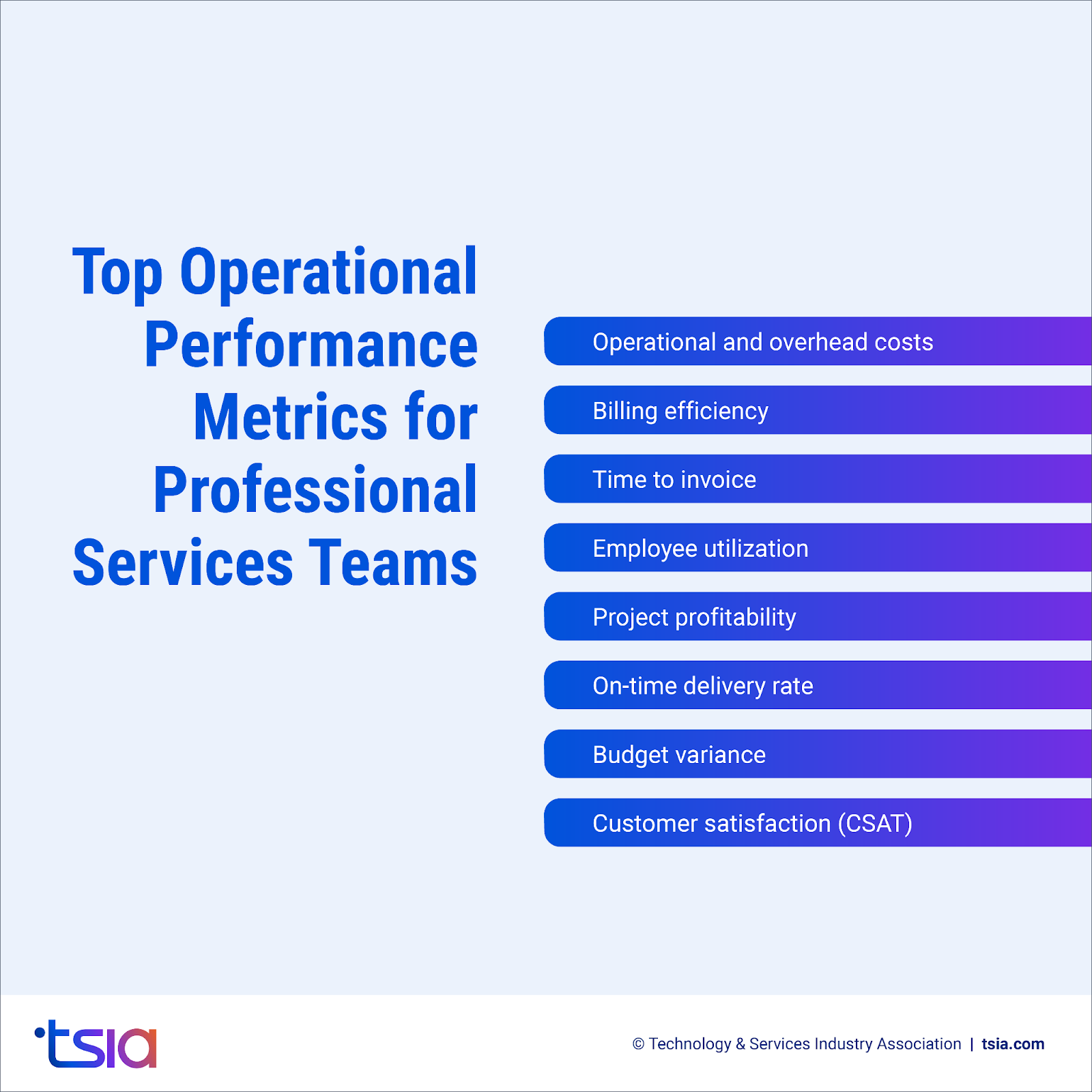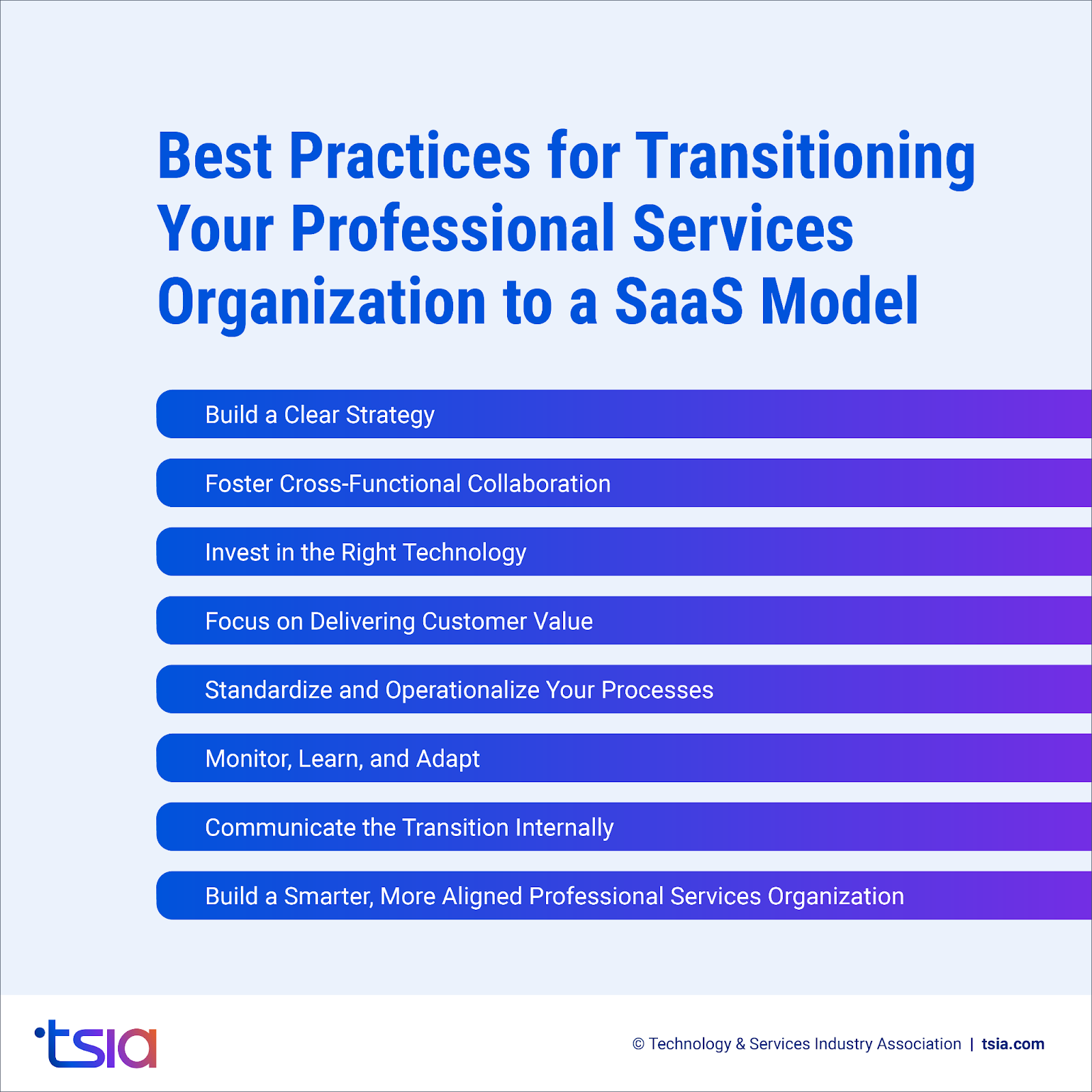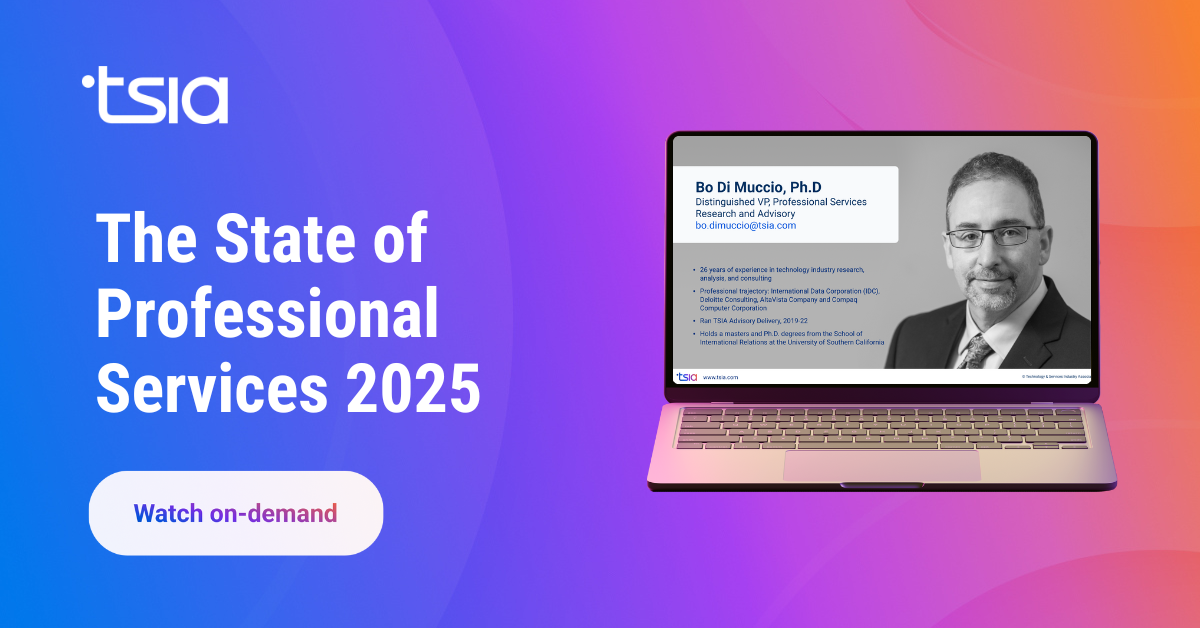If you're responsible for running or leading a professional services team, chances are you're asking the same questions many others are asking TSIA Intelligence. Through TSIA Intelligence—our AI-powered insight engine built for tech services—we've identified the most frequently asked questions from professionals in your field.
From measuring your team's operational performance to structuring governance and transitioning to a Software-as-a-Service (SaaS) model, these topics reflect the most pressing challenges for service organizations today. This blog breaks down the top questions your peers are asking—and gives you clear, actionable answers.
Key Takeaways:
- Operational metrics matter: Tracking key metrics such as utilization, profitability, and billing efficiency provides a clear view of how well your services team is performing—and where there’s room for improvement.
- Strong governance drives alignment: A well-structured charter and cross-functional decision-making process help ensure your services team stays aligned with broader company goals.
- SaaS changes everything: Transitioning to a SaaS model necessitates new strategies, technologies, and perspectives on roles, success, and customer value.
What Are the Most Important Operational Performance Metrics for Your Professional Services Team?
If you're looking to improve how your professional services team operates, tracking the right operational metrics is key. These internal performance indicators help you understand how efficiently your team delivers services, manages resources, and supports the business financially.
Key Metrics to Keep an Eye On
Here are the top metrics your professional services organization (PSO) should be monitoring:
- Operational and overhead costs: These reveal how much you’re spending to deliver services, including both direct project expenses and indirect support costs like administration.
- Billing efficiency: Measures how well you convert your team’s time into billable hours. A higher rate means you're maximizing revenue from the work you’re already doing.
- Time to invoice: Tracks how quickly you send invoices after a project wraps. The faster you bill, the quicker you get paid.
- Employee utilization: This indicates the percentage of your consultants' time that is billable. It’s a key indicator of resource efficiency and revenue potential.
- Project profitability: Calculates the financial success of each project by comparing revenue to costs.
- On-time delivery rate: Indicates how frequently you meet project deadlines—a key indicator of strong project management.
- Budget variance: Compares planned costs to actual spending, helping you stay financially on track.
- Customer satisfaction (CSAT): While CSAT is typically tied to service delivery, it also reflects how well your operations support a positive client experience.
Don’t Forget About Effectiveness
Beyond these metrics, it’s also essential to measure the effectiveness of your operations. That includes:
- Process efficiency: Are your internal workflows helping or hurting your ability to deliver?
- Resource availability: Can you deploy the right people at the right time?
- Financial reporting accuracy: Reliable data means better decisions and better performance.
Tracking these metrics gives you a clear view of what’s working—and what’s not—so you can fine-tune your operations and drive better results.
Related: Leaping Over the Adoption Chasm: Professional Services in the Driver's Seat

How Should You Structure a Charter and Governance Model for Your Professional Services Organization?
If you're leading or managing a professional services organization, having a well-defined charter and governance structure is essential. These elements serve as the backbone of your strategy, aligning your team’s priorities with broader business goals and ensuring that decisions are made efficiently and collaboratively.
What Should Go Into Your Charter?
Your charter outlines your professional services organization’s mission, priorities, and how success will be measured. Here’s what it should include:
- Mission and value proposition: Clearly define your team's purpose. Are you primarily focused on creating customer value, generating revenue, improving profit margins, or supporting sales efforts?
- Core priorities: Identify your top priorities—customer value, sales enablement, professional services revenue, or profit margin. These will help guide how you allocate resources and make strategic decisions.
- Trade-offs: Be transparent about the trade-offs between priorities. For example, prioritizing customer value might mean sacrificing short-term revenue. Clarifying this helps align stakeholder expectations.
- Performance metrics: Select key performance indicators (KPIs) that align with your objectives. This could include metrics for employee utilization, project profitability, customer satisfaction, or operational efficiency.
Building a Strong Governance Framework
Governance sets the rules for how your organization makes decisions. A good governance model ensures collaboration and alignment across departments:
- Cross-functional engagement: Involve stakeholders from sales, product management, customer success, finance, and more. This keeps your charter relevant and helps prevent silos or misaligned expectations.
- Decision rights and escalation paths: Clearly define who makes which decisions, when to escalate issues, and how different regions or departments stay aligned.
- Regular review processes: Revisit your charter regularly—ideally on an annual basis—to ensure it remains aligned with evolving business goals.
- Documentation and communication: Once finalized, document the charter clearly and share it with the entire organization. Everyone should understand what it means and why it matters.
By taking the time to define a clear mission, set strategic priorities, and build a governance model that encourages cross-functional input, you’re setting your professional services organization up for long-term success.
Related: What is Professional Services: A Quick Guide
What Are the Best Practices for Transitioning Your Professional Services Organization to a SaaS Model?
As more companies shift to subscription-based offerings, professional services organizations like yours need to rethink how services are delivered. Moving to a Software-as-a-Service (SaaS) model isn’t just about technology—it requires changes to strategy, structure, and culture. Here are the best practices to guide your transition to SaaS, ensuring long-term success.

Build a Clear Strategy
Begin with a documented strategy that clearly defines your mission, goals, and how professional services will support your SaaS business. Make sure this strategy:
- Outlines expected outcomes.
- Aligns with company-wide objectives.
- Clarifies the role of professional services in driving renewable revenue.
Foster Cross-Functional Collaboration
Include voices from across your business—sales, product management, customer success, operations. This collaboration helps ensure alignment and supports a smoother shift to subscription services.
Redefine Roles and Responsibilities
Transitioning to SaaS changes what success looks like. Your team members may need to:
- Shift from short-term project focus to long-term customer value.
- Prioritize retention and renewals alongside delivery.
- Receive new training and support to adapt their approach.
Invest in the Right Technology
Integrated systems make it easier to track customer behavior and manage subscriptions. You’ll want tools that support:
- Subscription lifecycle and pricing models.
- Customer usage data (consumption telemetry).
- Order management and analytics.
Focus on Delivering Customer Value
Understanding and delivering value to your customers is more important than ever. This means:
- Capturing real-time data on how customers use your services.
- Using those insights to improve your offerings and service experience.
Standardize and Operationalize Your Processes
Create repeatable processes tailored for the SaaS environment, such as:
- Defined service tiers and packages.
- Standard delivery workflows.
- Built-in flexibility for continuous improvement.
Monitor, Learn, and Adapt
Track key metrics, including customer satisfaction, renewal rates, and service utilization. These insights will help you:
- Spot what’s working—and what’s not.
- Make data-informed adjustments to your approach.
Communicate the Transition Internally
Keep everyone in the loop. Communicate why the transition is happening, how it affects each team, and what success looks like. Transparency builds support and minimizes friction.
By focusing on these key areas, you can help your professional services organization evolve with the industry and deliver greater value in a subscription-based world.
Related: PSO Journey to a Subscription Model

Build a Smarter, More Aligned Professional Services Organization
As professional services continue to evolve, the questions you ask—and the answers you act on—can make a big difference in how your team performs. By focusing on operational performance, clarifying your governance model, and preparing for a SaaS future, you’re not just keeping up—you’re setting your team up for long-term success.
Whether you're refining internal processes or rethinking how your services organization supports recurring revenue, TSIA Intelligence can guide you with data-backed, actionable insights every step of the way.
FAQs
What are the most critical topics professional services leaders are focused on right now?
Professional services leaders are prioritizing operational efficiency, strategic alignment, and preparing for recurring revenue models, such as Software-as-a-Service (SaaS). This blog highlights the top questions being asked by your peers in the TSIA Portal—from how to track the right performance metrics to how to evolve your team’s structure and strategy for the future.
What is TSIA Intelligence, and how can it help me?
TSIA Intelligence is an AI-powered tool available in the TSIA Portal that surfaces the most relevant answers and insights based on your top business challenges. It draws on TSIA’s rich research library to help you make informed decisions more quickly.
What’s the difference between TSIA Intelligence and the Performance Optimizer?
TSIA Intelligence helps answer specific questions and guide decisions in real time. The Performance Optimizer, on the other hand, is a tool that provides deeper benchmarking and performance insights based on structured inputs about your business.
Smart Tip: Embrace Data-Driven Decision Making
Making smart, informed decisions is more crucial than ever. Leveraging TSIA’s in-depth insights and data-driven frameworks can help you navigate industry shifts confidently. Remember, in a world driven by artificial intelligence and digital transformation, the key to sustained success lies in making strategic decisions informed by reliable data, ensuring your role as a leader in your industry.













